| |
|
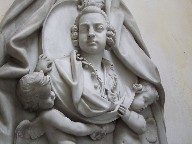 |
|
If you
passed this church, you’d probably
not think it was anything remarkable. You’d
agree it was rather pretty, with its tiny
clerestory, and that the churchyard was
trim and well-cared for. Wilby is so
small that you probably wouldn’t
even notice you’d come through a
village if it wasn’t for the church,
sitting beside the winding road. There’s
nowhere to park outside the church, so if
you were in a car, and you missed the
spaces outside the school, you would
probably just keep going. Alook alone
would not show you that the door was
open, and that this was a welcoming
place. It certainly wouldn’t tell
you that this little church has one of
the finest collections of medieval bench
ends in East Anglia. I have written extensively
on this site about medieval bench ends,
and I don’t propose to do so again
here. If you are interested, try the
entry for Woolpit for starters, and
follow the links elsewhere. Medieval
bench ends can be found all over Suffolk,
but there are particular concentrations,
and one of the hotspots is up here in the
north of the county. Broadly speaking,
Suffolk’s bench ends can be divided
into four groups: images of real and
mythical creatures, images of everyday
life, images of Saints, and images of the
teachings of the church.
|
In
general, the Anglican reformers of the 16th
century, and the puritan reformers of the 17th,
left the first group alone. Bench ends in the
second group were only circumspect if they
included religious imagery; thus, the lady
walking her dog at Ixworth Thorpe survives in all her glory,
but figures holding rosaries were often
decapitated. Surprisingly, there are a
considerable number of surviving bench ends in
the third group, most notably at Ufford and Athelington.
It
is the fourth group that has suffered. Here at
Wilby, the bench ends represent the seven
sacraments, the seven works of mercy, and the
seven deadly sins. Almost all of them are
mutilated, just as if someone had wandered up and
down the aisles swinging an axe at them; and they
probably did.
It
was nearly ten years since I had last visited
Wilby church, back in the days before I had a
digital camera, so I thought it was time to make
a return visit. It was one of those sunny spring
days that seem to wipe out all the miseries of
winter. A man was cutting the grass, which I
thought a not unpleasant way of spending a sunny
Saturday afternoon, as long as I didn’t have
to do it myself. The graveyard was full of rooks,
which was very atmospheric. I wandered around the
outside of the church, noticing that, although St
Mary isn't big, the south porch is one of those
grand affairs for which Suffolk is famous. It is
lavish in its use of Catholic imagery, denoting a
date on the eve of the Reformation. Wingfield
symbols are here too. Above it, there is a
gorgeous clerestory and a nicely-proportioned
tower. The clerestory is not repeated on the
north side, and in general it seemed to me that
much of the flint-work in the walls was a 19th
century restoration. But the general impression
is of a well-kept building with evidence of its
life down the ages.
Inside
the church, a lady was preparing flowers on the
south aisle altar. There is no north aisle,
giving the interior a pleasing asymmetry. To the
left of the entrance, at the west end of the
aisle, is an extraordinary mausoleum to the Green
family, which includes a lovely relief on the
north wall. Nearby are lead panels from the roof,
bearing churchwardens' initials, as at Kenton.
There
is a striking St Christopher facing the entrance.
Much has been defaced, but you can still see the
Saint's house, and the seafood at his feet is
delightful. In front of it, the font is intriguing, a mass of
15th century detail, rather more elaborate than
most. The figures arond the stem are the best
bit. As well as the four evangelists, it includes
St Paul, and a figure that Mortlock thought might be St James,
in which case it would be a rare survival.
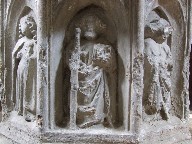 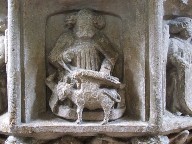 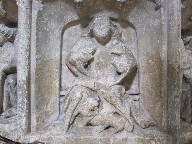
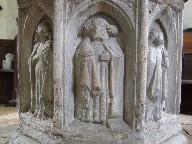 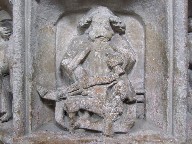 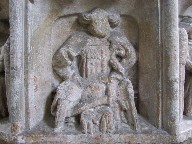
The
interior is generally Victorianised, in a
pleasant, simple manner. There is a Green
hatchment, an unidentified brass, and some
overlarge union flags. The angels in the aisle
are by the Darlings of Eyke, rather more intricate
than their single angel at Bromeswell. There is a scattering of
medieval glass in the tracery of the north side.
There are angels and eagles, Saint Catherine and
Saint Osyth, as well as other Saints.
That
it should have survived at all is worth remarking
on. William
Dowsing
came this way on the 4th of April 1644, and he
was in a bad mood. So much so, that the entry in
his journal is rather confused. Superstitious
pictures, he writes; 30 we brake down;
and gave order to take 10 more; and the steps to
be levelled; and the whip, and pincers, and
nayles, that was at Christ's crucifying; and the
Trinity, all in stone.
Pictures
means images in stained glass. Probably, the
thirty were within reach of the churchwardens'
ladder, but ten weren't, so were marked down for
another day. It would be nice to think that the
churchwardens ignored him, and these were the
ones that survived, but there's no reason to
think that they weren't as supportive to the
puritan project here as they were almost
everywhere else in Suffolk. The chancel steps had
been raised up under the orders of Archbishop
Laud
within the last fifteen years, and their
levelling is a familiar part of Dowsing's work.
The instruments of the Passion and the symbol of
the Trinity are a bit of a problem, however.
Usually, we expect to find them on the font, but
there is nowhere that they could have been. On
the porch is another possibility, but again it is
hard to see where they could have been, and a
Marian monogram on the porch has survived, which
surely would have been noticed if the iconoclasts
had set about it. Perhaps the reflinting of the
external walls in recent years is a clue, but it
remains a mystery.
Dowsing
arrived here fairly early that morning - it was a
Thursday, and he had spent the previous day in a
leisurely manner, visiting just four adjacent
parishes, including neighbouring Brundish. This
suggests, of course, that he was staying locally,
and perhaps had other personal business to
pursue. There was a Dowsing home in nearby Laxfield; but we know that he also
owned land in the Parishes of Wilby and Brundish, so there is the
intriguing possibility that he actually spent the
night here. This day, he would also visit Stradbroke and Linstead Parva - but that was all. On the
Friday, he'd still be around for Linstead Magna, so the evidence is pretty
strong that he was doing something else locally.
Perhaps he was also collecting rent on his Wilby
and Brundish smallholdings.
I
wonder what he made of the bench ends. They are
in three ranges. Those against the north wall are
medieval, and include the seven sacraments, St
John the Baptist and St Barbara. In the south
aisle they are also medieval, and include the
seven works of mercy and the seven deadly sins.
The central block and those in the chancel are
19th century.
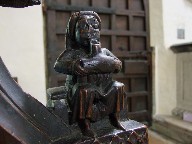 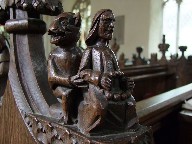 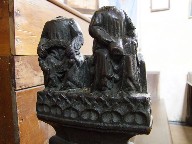 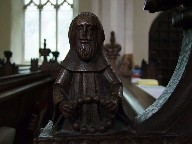 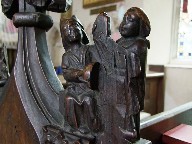
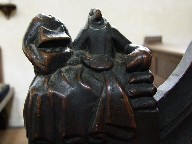 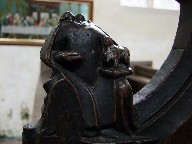 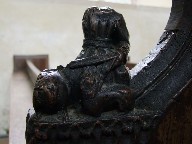 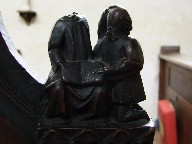 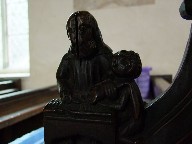
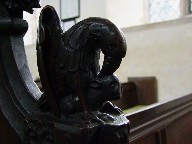 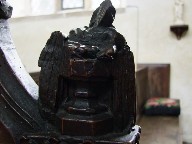 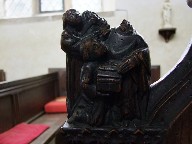 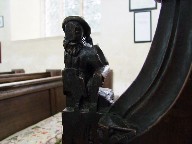 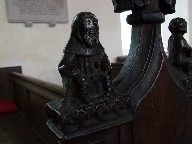
The
medieval Wilby bench ends are part of a wider
group; the ones at Tannington and Bedingfield are almost certainly by
the same artist. They are of a high quality, so
it might not have been the work of a local;
perhaps they were all part of a group commission,
or perhaps they were even once all in the same
church.
| All three
of these churches are a pleasure to
visit, not least because they are all
open to visitors during the day. Wilby is
particularly fun, because during the 19th
century somebody had a go at reproducing
the medieval bench ends as if they had
never been mutilated. I wondered if this
might have been the Darlings as well,
which would make them slightly later, but
they are quite different in quality to
their work at Eyke. These are the
benches that now fill the middle range,
and it is interesting and instructive to
compare the modern copies with the
medieval originals. The 19th century
bench ends also include some mythical
beasts, which my nine year old son liked
best of all. This is a lovely
church; fascinating and well-kept without
being a museum or a Sunday club; even
more interesting than the nearby
better-known Fressingfield, I think. I
commend it to your attention.
|
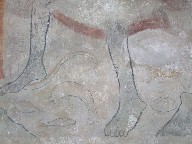 |
|
|
|

